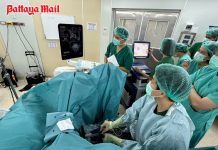Geneva, 28 February 2013 – A comprehensive assessment by international experts on the health risks associated with the Fukushima Daiichi nuclear power plant (NPP) disaster in Japan has concluded that, for the general population inside and outside of Japan, the predicted risks are low and no observable increases in cancer rates above baseline rates are anticipated.
The World Health Organization (WHO) report ‘Health Risk Assessment from the nuclear accident after the 2011 Great East Japan Earthquake and Tsunami based on preliminary dose estimation’ noted, however, that the estimated risk for specific cancers in certain subsets of the population in Fukushima Prefecture has increased and, as such, it calls for long term continued monitoring and health screening for those people.
Experts estimated risks in the general population in Fukushima Prefecture, the rest of Japan and the rest of the world, plus the power plant and emergency workers that may have been exposed during the emergency phase response.
“The primary concern identified in this report is related to specific cancer risks linked to particular locations and demographic factors,” says Dr Maria Neira, WHO Director for Public Health and Environment. “A breakdown of data, based on age, gender and proximity to the nuclear plant, does show a higher cancer risk for those located in the most contaminated parts. Outside these parts – even in locations inside Fukushima Prefecture – no observable increases in cancer incidence are expected.”
In terms of specific cancers, for people in the most contaminated location, the estimated increased risks over what would normally be expected are:
* All solid cancers – around 4% in females exposed as infants;
* Breast cancer – around 6% in females exposed as infants;
* Leukemia – around 7% in males exposed as infants;
* Thyroid cancer – up to 70% in females exposed as infants (the normally expected risk of thyroid cancer in females over lifetime is 0.75% and the additional lifetime risk assessed for females exposed as infants in the most affected location is 0.50%).
For people in the second most contaminated location of Fukushima Prefecture, the estimated risks are approximately one-half of those in the location with the highest doses.
The report also references a section to the special case of the emergency workers inside the Fukushima NPP. Around two-thirds of emergency workers are estimated to have cancer risks in line with the general population, while one-third is estimated to have an increased risk.
The almost-200-page document further notes that the radiation doses from the damaged nuclear power plant are not expected to cause an increase in the incidence of miscarriages, stillbirths and other physical and mental conditions that can affect babies born after the accident.
“The WHO report underlines the need for long-term health monitoring of those who are at high risk, along with the provision of necessary medical follow-up and support services,” says Dr Maria Neira, WHO director for Public Health and Environment. “This will remain an important element in the public health response to the disaster for decades.”
“In addition to strengthening medical support and services, continued environmental monitoring, in particular of food and water supplies, backed by the enforcement of existing regulations, is required to reduce potential radiation exposure in the future,” says Dr Angelika Tritscher, acting director for WHO’s Food Safety and Zoonosis Department.
As well as the direct health impact on the population, the report notes that the psychosocial impact may have a consequence on health and well-being. These should not be ignored as part of the overall response, say the experts.
This is the first-ever analysis of the global health effects due to radiation exposure after the Fukushima NPP accident and is the result of a two-year WHO-led process of analysis of estimated doses and their potential health implications. The independent scientific experts came from the fields of radiation risk modeling, epidemiology, dosimetry, radiation effects and public health.
The WHO Health Risk Assessment from the nuclear accident after the 2011 Great East Japan Earthquake and Tsunami based on preliminary dose estimation can be viewed at www.who.int/ and www.who.int/phe




